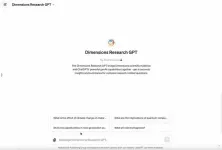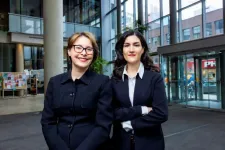Unlike most animals that rely on visual senses, bats navigate and locate prey or obstacles through echolocation. By emitting sounds and comparing them to the reflected echoes, bats can “visualize” movement in the environment. When sound waves encounter a moving object, they can undergo changes such as a Doppler shift in frequency or experience a delay, which the bat can sense. However, it is unclear which acoustic characteristics bats rely on to detect moving objects.
Japanese horseshoe bats (Rhinolophus ferrumequinum nippon) emit ultrasound pulses that are characterized by a constant frequency (CF) component followed by a frequency-modulated (FM) component. These bats use a combination of echo delays and Doppler shifts for perceiving the environment. In a recent study published in the journal iScience on February 28, 2024, Professor Shizuko Hiryu and her team, including Mr. Soshi Yoshida, a first-year Ph.D. student, from Doshisha University, and Dr. Kazuma Hase from University of Toyama, Japan, have revealed the acoustic features Japanese horseshoe bats sense when perceiving moving objects.
Explaining the motivation behind this study, Mr. Yoshida explains, “Investigating the bats' sonar strategies, which utilize acoustic sensing, can offer insights into the perception of sound and have potential applications for ultrasonic sensing technology.”
Echoes from any approaching object are distinguished using the presence of Doppler shift and changes in echo delay. CF–FM echolocating bats are sensitive to both, so the authors hypothesized that they use both or either the “delay change” and “Doppler shift” information.
To test their hypothesis, researchers created artificial soundwaves with added echo delays and Doppler shifts to resemble the acoustic signals bats encounter when an object is in motion. They then played these simulated sounds to the bats and observed their response. To simulate the virtual approaching object, the researchers recorded sounds emitted by perched bats using a microphone placed 1 meter away. After real-time signal processing, which included a delay of approximately 1 ms, these sounds were played back to the perching bats through a loudspeaker positioned beside the microphone. Initially, the bats were exposed to soundwaves representing a stationary virtual object. The researchers then changed the echo delay to mimic an object at 1.7–1.2 m away moving closer to the bats. Additionally, they adjusted frequency shifts in phantom echoes through heterodyning to incorporate the effects of Doppler shifts.
When both Doppler shifts and echo delays were manipulated, the team found that the bats exhibited vocalization changes and evasive behavior similar to when a real object was moved towards them. Specifically, there was a decrease in CF component duration and an increase in FM bandwidth.
When only echo delays were manipulated, none of the bats exhibited clear changes in emitted sounds or escape behavior. However, when positive Doppler shifts were introduced alone, seven out of nine bats displayed a take-off behavior, and their echolocation pulses changed similarly to when a real object approached them. This indicated that bats primarily rely on Doppler shifts rather than changes in echo delay to detect moving objects while perched.
“Only the Doppler shifts, not the temporal changes in echo delay, acted as a cue. Velocity is directly perceived, not temporal changes in position as in vision. Taking advantage of acoustic sensing, the bats enabled instantaneous threat avoidance,” explains Prof. Hiryu.
Their findings not only deepen our understanding of acoustic sensing in the natural world but also have the potential to advance the development of sensors for robots. For instance, in a cluttered environment, recognizing moving objects using an echo delay might be challenging due to overlapping sound waves from the target and irrelevant objects. In such cases, sensors based on Doppler shifts might be more effective.
Mr. Yoshida concludes by saying, “The understanding of ultrasonic sensing gained from bats could lead to the development of ultrasonic sensors. For example, it would be great if a robust motion detection sensor is developed based on this research.”
About Soshi Yoshida from Doshisha University, Japan
Soshi Yoshida is a Ph.D. student in the Neuroethology and Bioengineering Lab at Doshisha University. He earned his graduate degree from the Graduate School of Life and Medical Science at Doshisha University before pursuing his doctoral studies. His research interests include echolocation in bats, biological sonar, animal bioacoustics, and ultrasonic engineering. He has actively participated in various conferences and was awarded the Research Encouragement Award by the Hearing Research Group in November 2023 for his work in reconsidering the Doppler shift compensation behavior and prey detection strategy of bats. In addition, he received two presentation awards in 2021 from the Japanese Society of Animal Psychology and the Acoustical Society of Japan for presenting his research on how echolocating bats recognize approaching objects.
Researcher profile
About Professor Shizuko Hiryu from Doshisha University, Japan
Shizuko Hiryu is a Professor in the Faculty of Life and Medical Sciences, Department of Biomedical Information at Doshisha University. She is a member of several academic societies and committees and has received numerous awards for her work on echolocation and bioacoustics in bats. Her research interests include ultrasonic engineering and bioacoustics communication and sensing. She has published extensively on these topics in scientific journals, including several papers on echolocation and acoustic simulations in bats. Her work has been recognized with awards such as the JAMSTEC Nakanishi Award, Ocean Acoustics Society Paper Award, and the JSPS Award.
Researcher profile
Lab page
Funding information
This work was supported by JSPS KAKENHI Grant Nos. 21H05295, JP19J02041, and JST SPRING Grant No. JPMJSP2129.
Media contact:
Organization for Research Initiatives & Development
Doshisha University
Kyotanabe, Kyoto 610-0394, JAPAN
E-mail:jt-ura@mail.doshisha.ac.jp
END





